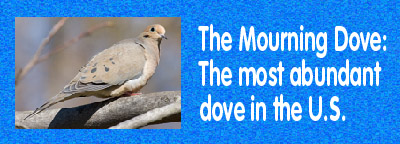This season's articles (Excerpted from our printed newsletter):
The Mourning Dove
The most abundant dove in the United States, the Mourning Dove, is also the most widely hunted and harvested game bird. Birdlife International estimates their population to be around 130 million. The name comes from the familiar, although easily-overlooked song, a low-toned moaning "cooah, coo, coo, coo." This dove, found across the US and southern Canada, is most common through the Great Plains in the Midwest. In our area, typically two eggs are laid in a nest made in an evergreen tree; although a wide variety of nest sites are used, including shrubs, vines, or clumps of grass.
 This species does very well in areas altered by humans. As settlers and immigrants cleared the forests that once covered much of North America and started growing crops, new habitats for the Mourning Dove opened up. They prefer open fields, parks, and lawns with many trees and shrubs. It avoids thick forest and swamps.
This species does very well in areas altered by humans. As settlers and immigrants cleared the forests that once covered much of North America and started growing crops, new habitats for the Mourning Dove opened up. They prefer open fields, parks, and lawns with many trees and shrubs. It avoids thick forest and swamps.
They eat almost exclusively seeds (corn, millet, safflower, sunflower), which make up more than 99% of their diet, not digging or scratching for food, but eating what is readily visible. Because they forage on the ground, they may also choose waste grain (wheat and buckwheat), weed seeds, and very occasionally fruits and insects. They will eat enough to fill their crop and then fly away to digest while resting. They often swallow grit such as fine gravel or sand to assist with digestion.
Four "Other Things" to Feed Birds
Did you ever wonder if birds got tired of eating the same old things? We have a few suggestions to break out of the old routine. Not all these suggestions may work in your backyard. After all, everyone's natural setting and feeder clientele are different. Again, these are just suggestions: Do what makes you and your birds happy.
- Holiday Nuts: Do you buy the unsalted holiday nuts in the shell? Have you had your fill and don't know what to do with the rest? How about cracking them and putting them out for the birds? It will be a special treat. Just make sure they are unsalted, as salt can dehydrate the birds. Put them in your tray feeder for woodpeckers, nuthatches, jays, and chickadees.
- Eggshells: Birds can use the extra calcium in eggshells during the winter. Save your shells, rinse them in the sink and then place them in a shallow pan to bake in your oven, 250 degrees for 20 minutes. This cleaning and baking eliminates the chance of being exposed to bacteria. Crush and add to your feeders.
- Grit: Birds can use grit for their gizzard. The gizzard is a muscular stomach that seed-eating birds have. Food passing through the gizzard is broken down as the gizzard's muscles contract. Grit resides in the gizzard, helping to speed the food processing. You can offer grit on the ground or on a platform feeder, anywhere the birds will find it.
- Pumpkin or Melon Seeds: Wash your seeds and dry them in the oven. Spread them out on a large platform feeder. Not all birds will be able to crack them open, but it's a treat for those with stronger bills.
Back to current newsletter













